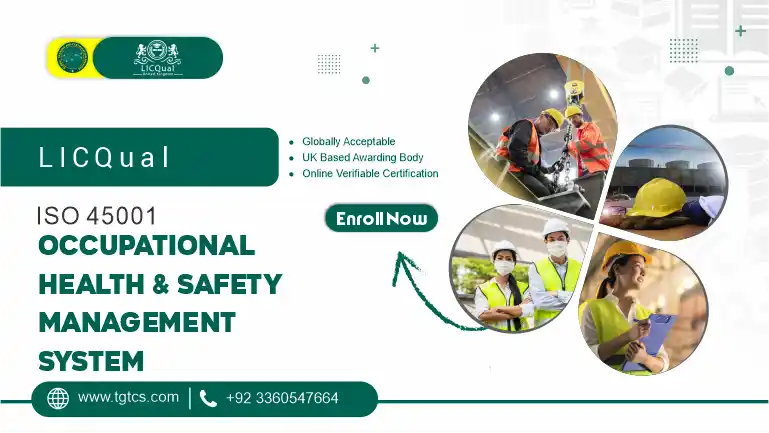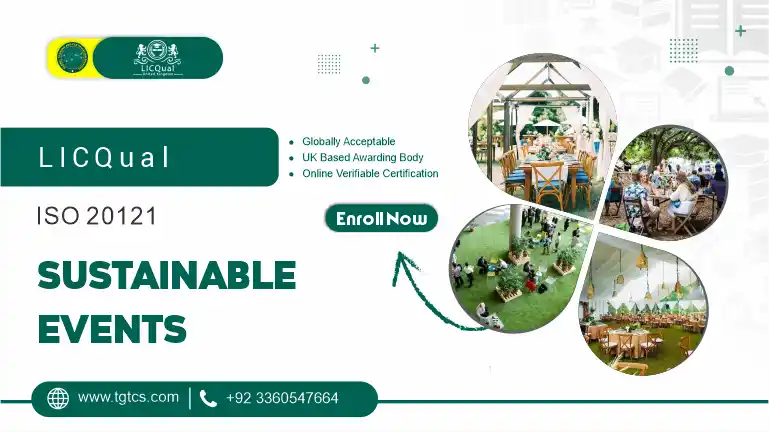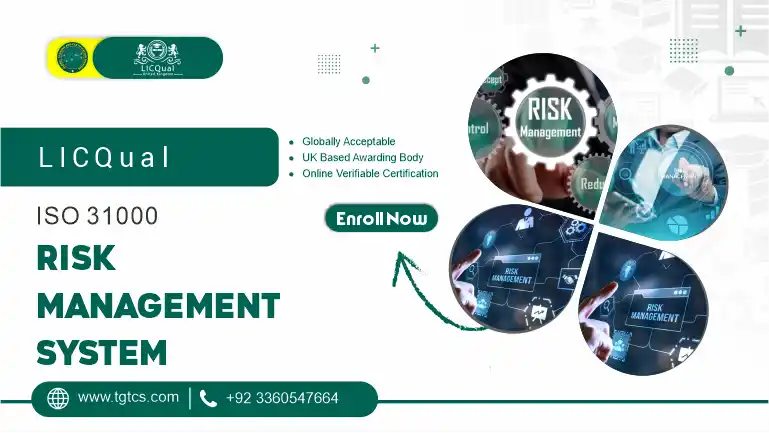LICQual ISO 45001 Occupational Health and Safety Management System
In today’s fast-paced work environment, ensuring the health and safety of employees is not just a legal obligation but a moral imperative. The ISO 45001 Occupational Health and Safety Management System (OHSMS) standard provides a framework for organizations to improve employee safety, reduce workplace risks, and create safer working conditions. At LICQual, we offer a comprehensive course designed to equip you with the knowledge and skills needed to implement ISO 45001 effectively.
The LICQual ISO 45001 Occupational Health and Safety Management System course is meticulously designed to provide participants with a thorough understanding of the principles and practices necessary for effective workplace safety management. Throughout the course, you will explore the key components of ISO 45001, including its structure and requirements, allowing you to grasp how to align your organization’s safety practices with international standards.
The curriculum emphasizes a proactive approach to identifying hazards and assessing risks, equipping you with the tools to develop comprehensive safety policies that not only comply with legal requirements but also foster a culture of safety within your organization.
Moreover, completing the ISO 45001 course not only enhances your professional qualifications but also demonstrates your commitment to fostering a safe working environment. As organizations increasingly prioritize health and safety, having expertise in ISO 45001 can set you apart in the job market, making you a valuable asset to your team. Whether you aim to implement ISO 45001 in your organization or seek certification, this course will provide the foundational knowledge and skills necessary for success.
The Global Training and Certification Services (TGTCS) is Directly Approved Training Centre of LICQual
The LICQual ISO 45001 Occupational Health and Safety Management System course offers a comprehensive exploration of the internationally recognized standard for occupational health and safety management. This course is designed for professionals seeking to enhance their understanding of workplace safety and implement effective health and safety management systems within their organizations.
Participants will gain in-depth knowledge of the ISO 45001 framework, including its key principles, requirements, and implementation strategies. The curriculum covers essential topics such as risk assessment and management, policy development, monitoring and continuous improvement, and auditing processes.
Through a combination of theoretical instruction, practical exercises, and real-world case studies, attendees will develop the skills necessary to identify hazards, assess risks, and create a culture of safety that complies with legal obligations and industry best practices.
By the end of the course, participants will be equipped to implement and manage an ISO 45001-compliant system, conduct internal audits, and drive continuous improvement in workplace safety. This course is ideal for health and safety managers, compliance officers, and organizational leaders committed to fostering a safe and productive work environment. Participants will also receive a certificate of completion, showcasing their commitment to occupational health and safety excellence.
Upon completion of the LICQual ISO 45001 Occupational Health and Safety Management System course, participants will be able to:
- Understand ISO 45001 Framework: Explain the structure and key requirements of the ISO 45001 standard, including its purpose and benefits for organizations.
- Conduct Risk Assessments: Identify workplace hazards and assess associated risks using systematic methodologies to determine necessary control measures.
- Develop and Implement Safety Policies: Create comprehensive occupational health and safety policies tailored to organizational needs, ensuring alignment with ISO 45001 standards.
- Establish an OHSMS: Design and implement an effective Occupational Health and Safety Management System that promotes a culture of safety and continuous improvement.
- Monitor and Evaluate Performance: Utilize key performance indicators (KPIs) to measure the effectiveness of health and safety initiatives and identify areas for improvement.
- Conduct Internal Audits: Prepare for and conduct internal audits to assess compliance with ISO 45001, ensuring the ongoing effectiveness of the management system.
- Foster a Safety Culture: Advocate for and implement practices that promote a positive safety culture within the organization, engaging employees at all levels.
- Prepare for Certification: Understand the steps necessary for ISO 45001 certification, including documentation requirements and external audit processes.
- Stay Updated on Regulatory Changes: Recognize the importance of keeping abreast of evolving health and safety regulations and industry best practices to maintain compliance.
- Network with Industry Professionals: Connect with peers and industry experts to share knowledge, experiences, and best practices in occupational health and safety management.
These learning outcomes equip participants with the essential skills and knowledge to effectively enhance workplace safety and contribute to a healthier, safer work environment.
Mandatory Units
- Occupational Health and Safety Management system
- Principles of Health and safety management system
- Elements of Health and safety management system
- Objectives of a health and safety management system
- The moral, legal and financial need for health and safety management system
- ISO 45001:2018 (OHS)
- Define ISO 45001:2018 OHS
- Benefits of adopting ISO 45001:2018
- Brief overview of ISO 45001:2018 Occupational Health and Safety management system clauses
- Overview of the ISO 45001:2018 standard & Clauses
- Introduction to ISO 45001:2018
- Clause 4 – Context of organisation
- Clause 5 – Leadership and Worker participation
- Clause 6 – Planning
- Clause 7 – Support
- Clause 8 – Operation
- Clause 9 – Performance Evaluation
- Clause 10 – Improvement
- Development of OHSMS standards
- Key changes in ISO 45001:2018
- Comparison between OHSAS 18001:2007 and ISO 45001:2018
- Conversion Process and Timeline
- Structure of Standards of ISO 45001:2018 (OHS)
- High Level Structure (HLS) and Plan-Do-Check-Act (PDCA) Model
- Internal Audit
- Internal Audit program
The Benefits of ISO 45001 Occupational Health and Safety Management System are as:
Enhanced Knowledge of Safety Standards: Gain a thorough understanding of ISO 45001, the leading international standard for occupational health and safety, enabling you to align your organization’s practices with globally recognized benchmarks.
Practical Skills Development: Learn how to conduct effective risk assessments, develop safety policies, and implement an Occupational Health and Safety Management System (OHSMS) that addresses the unique needs of your workplace.
Improved Workplace Safety: Acquire tools and strategies to identify and mitigate hazards, ultimately reducing the risk of accidents and promoting a safer work environment for all employees.
Increased Compliance: Stay compliant with legal and regulatory requirements, minimizing the risk of fines and penalties associated with health and safety violations.
Boosted Employee Morale and Productivity: Foster a culture of safety that enhances employee well-being, leading to increased job satisfaction, morale, and overall productivity.
Auditing Expertise: Develop the ability to conduct internal audits and assessments, ensuring your organization maintains compliance with ISO 45001 and identifies areas for improvement.
Networking Opportunities: Connect with fellow professionals and industry experts, sharing insights and experiences that can enhance your understanding of best practices in occupational health and safety.
Career Advancement: Enhance your professional credentials and marketability by gaining specialized knowledge in ISO 45001, positioning yourself as a valuable asset to your organization.
Certification Readiness: Prepare for the certification process, equipping you with the knowledge and confidence to guide your organization through achieving ISO 45001 compliance.
Commitment to Continuous Improvement: Learn how to foster a culture of continuous improvement in health and safety practices, ensuring ongoing enhancements to workplace safety standards.
The ideal learner for the LICQual ISO 45001 Occupational Health and Safety Management System course typically possesses the following characteristics:
- Health and Safety Professionals: Individuals currently working as health and safety managers, officers, or coordinators who seek to enhance their understanding of international standards and improve their organization’s safety practices.
- Compliance Officers: Professionals responsible for ensuring that their organization complies with health and safety regulations, looking to deepen their expertise in managing occupational health and safety systems.
- Operational Managers: Managers and supervisors who oversee teams and want to foster a safe working environment while understanding their responsibilities in maintaining compliance with safety standards.
- Human Resources Personnel: HR professionals interested in integrating health and safety practices into their organizational culture and ensuring employee well-being.
- Quality Assurance Professionals: Individuals involved in quality management who wish to incorporate health and safety considerations into their overall quality assurance framework.
- Safety Auditors: Internal or external auditors seeking to understand the auditing processes specific to ISO 45001 and improve their ability to assess occupational health and safety management systems.
- Industry Leaders and Executives: Senior management or organizational leaders aiming to promote a culture of safety and ensure their company adheres to best practices in occupational health and safety.
- Consultants: Professionals providing advisory services on health and safety, who want to gain in-depth knowledge of ISO 45001 to better serve their clients.
- Individuals Seeking Career Advancement: Anyone interested in expanding their knowledge in occupational health and safety management, particularly those aiming to enhance their career prospects in this field.
- Students and Academics: Learners in fields related to health, safety, and environmental management who want to acquire practical knowledge and skills that will benefit their future careers.
Course Overview
Standard Course
ISO 45001
Course Units
05 Mandatory Units
Duration
2 to 3 Weeks






